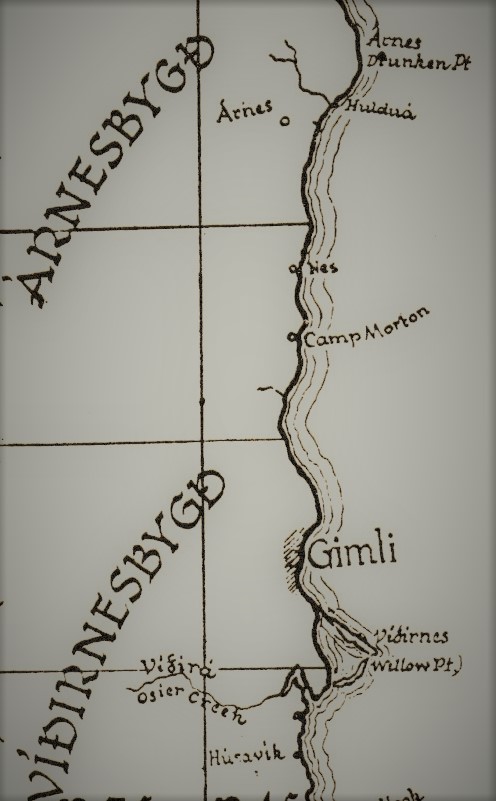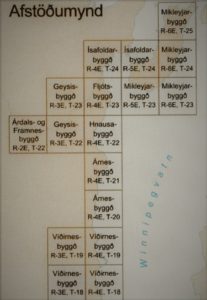 Arnes Settlement: The Víðirnes Settlement (Víðirnesbyggð) is the southernmost settlement of New Iceland and reached a few kilometers north of Gimli. The Arnes Settlement (Árnesbyggð) then took over. Arnes is a small headland, so to speak, just north of the Hulda River (Hulduá). Settlers first came to this area in 1876, the only way there was by the lake. One of those who came there in this year was a young man, Eggert Jóhannsson from Steinsstaðir in Skagafjörður. He later became the editor of Heimskringla in Winnipeg and was heavily involved in the history of Western Icelanders during the Emigration Period. He wrote his memoirs which were published in Tímarit Þjóðræknisfélag. About the year 1876 he said: “Although the resemblance of New Iceland almost half a century ago (1876), was in its entirety the same as it is now (circa 1925), no one who was not there in the early years, made clear to himself the feigned difference which has become. No one who was not there before and took a full part in all the original trouble and hardship can imagine what a difficulty it was to travel on foot over land, even if it was not more than a quarter of a mile. From the landing on the beach sand, there was no path and no one had stepped out into the endless forest, except in a six-mile-long area south of the colony, from the year before. But the surveying lines are the best beacons in the forest. Those who started a new home in 1876 had never seen a forest tree until their journey west, most of the time when in motion. Now their future world had become one forest. Where marshy land did not reach the shore sand, the lake bank was often high and steep to walk, especially in the Arnes Settlement. But whether the bank was high or low, it was well guarded in most places and offered the settlers protection. Tall and squat, white-gray espitré (poplar), stood very firmly at the front of the bank. But as they were struggling, the roadblocks soon became clear to the settlers that the bush and the new plant turned out to be “seven times more harmful to all the others”, as Hjálmar from Bólu said. Stunted, hard as glass, and leathery undergrowth, tall as a man or more, grew so dense between the trees that a sewing needle could not be “stuck down”. Those who made their way through the unsightly vegetation had to be very careful to keep their eyes open and protect their faces from scratches.
Arnes Settlement: The Víðirnes Settlement (Víðirnesbyggð) is the southernmost settlement of New Iceland and reached a few kilometers north of Gimli. The Arnes Settlement (Árnesbyggð) then took over. Arnes is a small headland, so to speak, just north of the Hulda River (Hulduá). Settlers first came to this area in 1876, the only way there was by the lake. One of those who came there in this year was a young man, Eggert Jóhannsson from Steinsstaðir in Skagafjörður. He later became the editor of Heimskringla in Winnipeg and was heavily involved in the history of Western Icelanders during the Emigration Period. He wrote his memoirs which were published in Tímarit Þjóðræknisfélag. About the year 1876 he said: “Although the resemblance of New Iceland almost half a century ago (1876), was in its entirety the same as it is now (circa 1925), no one who was not there in the early years, made clear to himself the feigned difference which has become. No one who was not there before and took a full part in all the original trouble and hardship can imagine what a difficulty it was to travel on foot over land, even if it was not more than a quarter of a mile. From the landing on the beach sand, there was no path and no one had stepped out into the endless forest, except in a six-mile-long area south of the colony, from the year before. But the surveying lines are the best beacons in the forest. Those who started a new home in 1876 had never seen a forest tree until their journey west, most of the time when in motion. Now their future world had become one forest. Where marshy land did not reach the shore sand, the lake bank was often high and steep to walk, especially in the Arnes Settlement. But whether the bank was high or low, it was well guarded in most places and offered the settlers protection. Tall and squat, white-gray espitré (poplar), stood very firmly at the front of the bank. But as they were struggling, the roadblocks soon became clear to the settlers that the bush and the new plant turned out to be “seven times more harmful to all the others”, as Hjálmar from Bólu said. Stunted, hard as glass, and leathery undergrowth, tall as a man or more, grew so dense between the trees that a sewing needle could not be “stuck down”. Those who made their way through the unsightly vegetation had to be very careful to keep their eyes open and protect their faces from scratches.
Here was the great forest of New Iceland, which had been talked about so often and so much during the journey. But few could have imagined what it was really like. What a menacing difference, to look around here or in the countryside at home in Iceland, and what a task it is, to clear away all this chaos, even if it was only for one day’s size. But here it was precisely for the purpose of clearing away the forest, so that the earth could produce daily bread, in one form or another. But the only thing that was visible to everyone was that there was no shortage of fuel or materials for building houses, both of which were an invaluable and good option. The lake was, of course, the highway, and the waterway went all the way, for those who set off from Gimli to explore the land and make a place for themselves. It seems that from the shore of the lake, up from each landing site, the settlers had their first battle with the forest. There they used their forest ax, most of them probably for the first time, to chop the undergrowth, cut apart fallen trees and cut down others, so that there would be an easy path from the shore and up to a certain house …. The summer was almost over – September started. It had to work hard, because two things had to happen at once and immediately: Build a hut over the people, so that it would be viable next winter, and gather hay to feed one or two cows and set up the cow shed.”

Photo: Gunnhildur Skaftadóttir MS thesis, 2008. From Víðirnes to Vindhljómur
Eggert’s description clearly shows how the settlement in the Arnes Settlement took place. Settlers came up by boat along the shore from Gimli to their land, came ashore and got to work. (See Position Figure). By the end of the year, 64 settlers had settled in the area, but by the end of 1879, almost all of them had moved away. Only six pioneers stuck it out. Some of those who emigrated to Winnipeg returned to their lands a few years later and lived there from then on. From 1883 there was a turnaround and people settled in the Arnes Settlement. Men were coming from Iceland until the turn of the century and either bought or studied land in the settlement. Sigurður Sigurbjörnsson took land and named it Árnes. There he opened the settlement’s post office in 1888 and ran Arnes P.O. for several years. He also had a shop there. The school district was formed in 1889 and a school was built in 1896. Jóhann Magnús Bjarnason was one of the school district’s first teachers. The Arnes congregation was formed in 1901 and the church of the congregation was built in 1911. The reading society Frón was born in 1910.
English version by Thor group.
